This 30-Minute Calabacitas Recipe Is Irresistible – Chefs Loved It. Will You?
Calabacitas recipe
Table of Contents
Introduction
If you’re craving a dish that’s comforting, colorful, and refreshingly wholesome, this calabacitas recipe is about to win you over. Whether you’re already a fan of Mexican-inspired home cooking or you’re just dipping your toes into the world of fresh veggie-forward meals, this one’s for you. Think of it as your perfect blend of simple ingredients, vibrant flavors, and a whole lot of heart, all coming together in one cozy skillet.
The best part? This calabacitas recipe is as easy as it is delicious. It’s light yet satisfying, packed with good-for-you ingredients like zucchini, corn, tomatoes, and green chiles, and it comes together in about 30 minutes. No fancy equipment, no complicated steps, just honest food that’s full of character.
In this post, we’ll cover everything you need to know to make this classic Southwestern favorite at home. From the story behind the dish to step-by-step prep, creative variations, and clever kitchen tips, you’ll walk away feeling confident and inspired to whip up your own version of calabacitas in no time.
Ready to fall in love with this easy, flavorful calabacitas recipe? Let’s get into it.
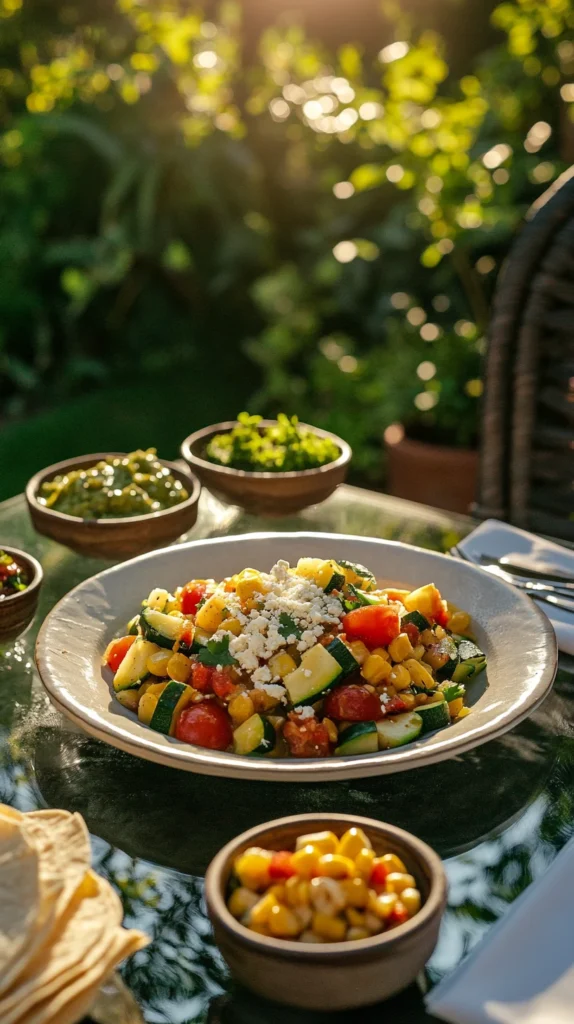
What Is Calabacitas?
“Calabacitas” is the Spanish word for “little squashes,” and the dish is just as charming as its name suggests. Typically made with zucchini or Mexican squash (calabacita), corn, onions, tomatoes, and green chiles, calabacitas is a staple in many Southwestern homes. While every family has its own version, the essence of the dish is a comforting vegetable medley that celebrates seasonal produce.
The calabacitas recipe we’re sharing today is a slightly fancy yet incredibly approachable take on the classic. It’s naturally gluten-free, vegetarian, and can be vegan with a couple of easy swaps. Best of all, it’s simple to whip up in about 30 minutes, making it perfect for weeknight dinners.
“For more on traditional variations, see Calabacitas con puerco, a classic Mexican version”
Ingredients Overview
The beauty of a good calabacitas recipe lies in the freshness of its ingredients. Here’s a breakdown of what you’ll need:
Vegetables
- Zucchini or Mexican squash (calabacita) – 3 medium, diced (about 450g)
- Corn kernels – 1 cup (fresh, frozen, or canned)
- Roma tomatoes – 2 medium, diced
- White or yellow onion – 1 medium, finely chopped
- Garlic cloves – 3, minced
- Green chiles – 1/2 cup diced (roasted Hatch green chiles are ideal)
Fats and Seasoning
- Olive oil or neutral oil – 2 tablespoons
- Salt – to taste
- Black pepper – to taste
- Ground cumin – 1/2 teaspoon (optional, for a smoky depth)
Optional Add-ins
- Cheese (cheddar, cotija, or Monterey Jack) – 1/2 cup shredded (about 60g)
- Cream or crema – for garnish
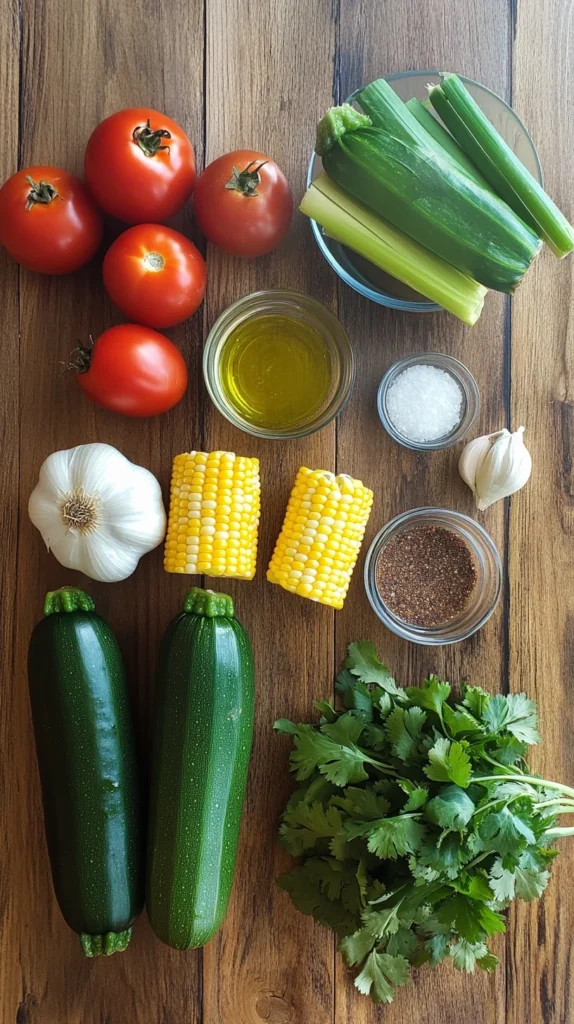
Step-by-Step Preparation Guide
Step 1: Prep the Vegetables
Wash and dice all vegetables. Having everything chopped before you start cooking makes the process smooth and enjoyable.
Step 2: Sauté the Aromatics
In a large skillet, heat the olive oil over medium heat. Add the chopped onion and sauté for 3-5 minutes, or until it becomes translucent. Stir in the minced garlic and cook for another 30 seconds.
Step 3: Add Zucchini and Chiles
Toss in the diced zucchini and green chiles. Stir occasionally and cook for 5-7 minutes, until the zucchini starts to soften.
Step 4: Incorporate Corn and Tomatoes
Add the corn and diced tomatoes. Continue cooking for another 5 minutes. At this point, the mixture will start to look juicy and colorful.
Step 5: Season and Finish
Season with salt, pepper, and cumin (if using). If you’re adding cheese, stir it in now and let it melt into the vegetables. Taste and adjust the seasoning as needed.
Step 6: Garnish and Serve
Serve hot, topped with a spoonful of crema or a sprinkle of cheese if desired. Calabacitas is delicious as a standalone dish or a side.
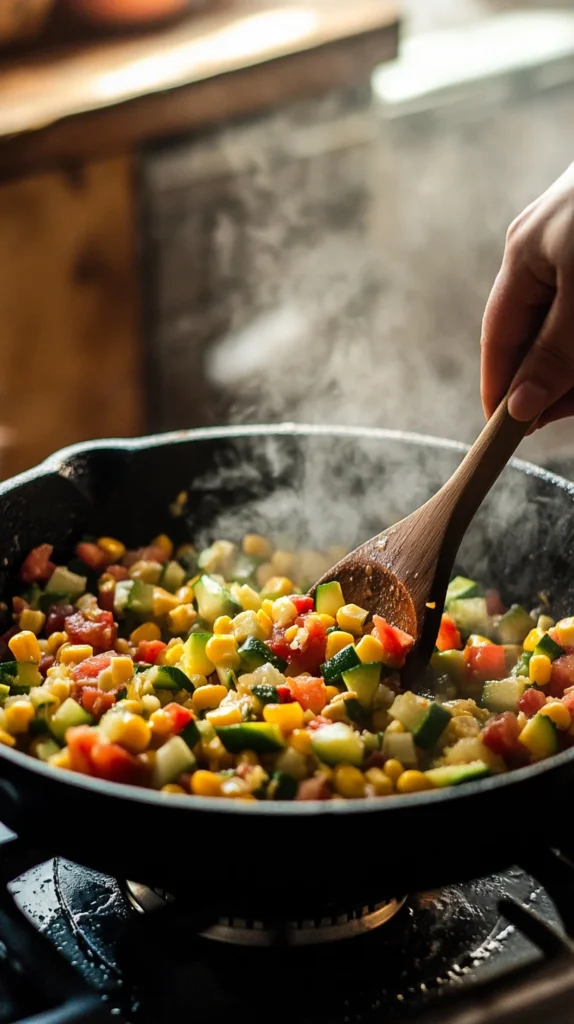
Variations to Try
This calabacitas recipe is wonderfully flexible. Here are some creative spins you can try:
- Add Protein: Stir in cooked chicken, ground beef, or crumbled tofu for a more filling meal.
- Make it Vegan: Skip the cheese and crema, or use plant-based alternatives.
- Spice it Up: Add a chopped jalapeño or a pinch of chili flakes for heat.
- Creamy Version: Stir in a splash of cream or coconut milk for a richer texture.
- Herbs and Greens: Add chopped cilantro, spinach, or kale at the end for an extra boost of flavor and nutrients.
“For a flavorful twist, try this Calabacitas a la Mexicana recipe from Food Network, incorporating jalapeños and oregano.”
Serving Suggestions
Calabacitas is the kind of dish that plays well with others. Here are a few serving ideas:
- As a Taco Filling: Spoon calabacitas into warm corn tortillas and top with avocado slices.
- Alongside Grilled Meat: It pairs beautifully with grilled chicken, steak, or fish.
- With Rice or Quinoa: Serve over a bed of rice or quinoa for a hearty vegetarian bowl.
- Topped on Nachos: Use it as a vegetable topping for nachos with melted cheese.
- With Eggs: Serve it as a savory breakfast alongside scrambled or poached eggs.
“Explore this Calabacitas con Elote recipe from Allrecipes for another delightful variation featuring zucchini and corn.”
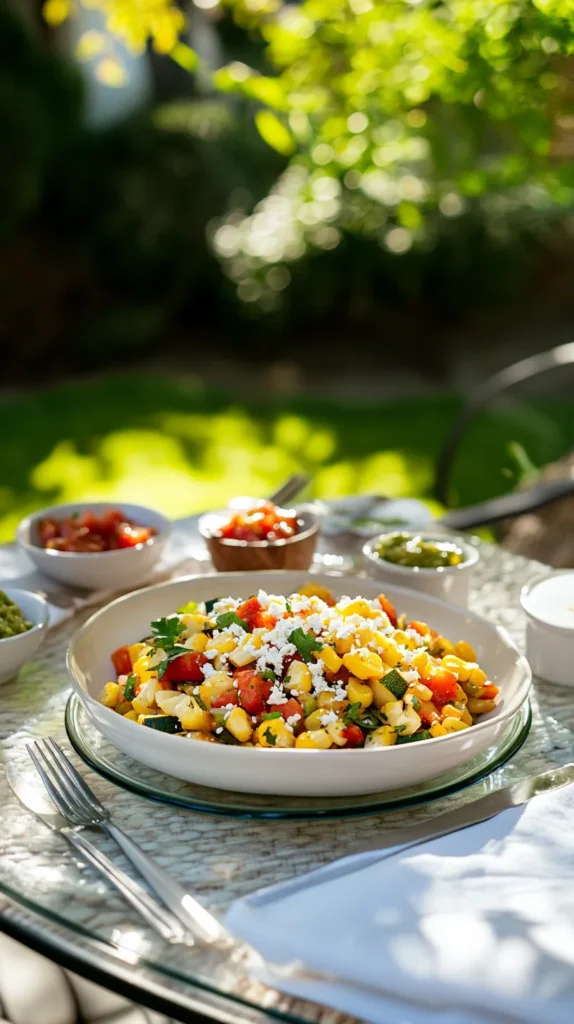
Tips and Tricks for the Perfect Calabacitas Recipe
Even though this calabacitas recipe is simple and quick, a few thoughtful tips can help you elevate it to something truly memorable. Here’s how to make every bite count:
1. Cook the Zucchini Just Right: Zucchini can turn mushy in a flash. Sauté it until just tender, so it keeps a slight firmness. This gives the dish texture and prevents it from becoming watery.
2. Go Fresh When You Can: Fresh produce = vibrant flavor. If you have access to fresh corn, ripe tomatoes, and seasonal zucchini, use them. Roasted fresh green chiles (like Hatch chiles) bring authenticity and a gentle kick.
3. Roast Your Chiles: If using fresh green chiles, roasting them before adding to the skillet brings depth and a light smokiness. It’s a small step that makes a big difference in flavor.
4. Season in Layers: Rather than salting only at the end, season each stage—onions, zucchini, tomatoes—as you go. Layered seasoning gives the dish more balance and dimension.
5. Brighten Before Serving: A splash of lime juice or a handful of chopped cilantro added just before serving brings the dish to life. It cuts through the richness and enhances all the other flavors.
6. Let It Rest: Give your calabacitas a minute or two off the heat before serving. It allows the vegetables to absorb the juices and meld together, improving both flavor and consistency.
7. Make Extra – Seriously: This calabacitas recipe stores beautifully. Make a bigger batch and enjoy it reheated in tacos, over rice, or with eggs the next day. The flavors deepen overnight, making leftovers even better.
Nutritional Information
Here’s a rough estimate per serving (based on 4 servings):
| Nutrient | Amount |
| Calories | 165 kcal |
| Protein | 4 g |
| Fat | 8 g |
| Carbohydrates | 20 g |
| Fiber | 4 g |
| Sugar | 6 g |
| Sodium | 280 mg |
Note: Nutrition may vary based on specific ingredients and add-ins.
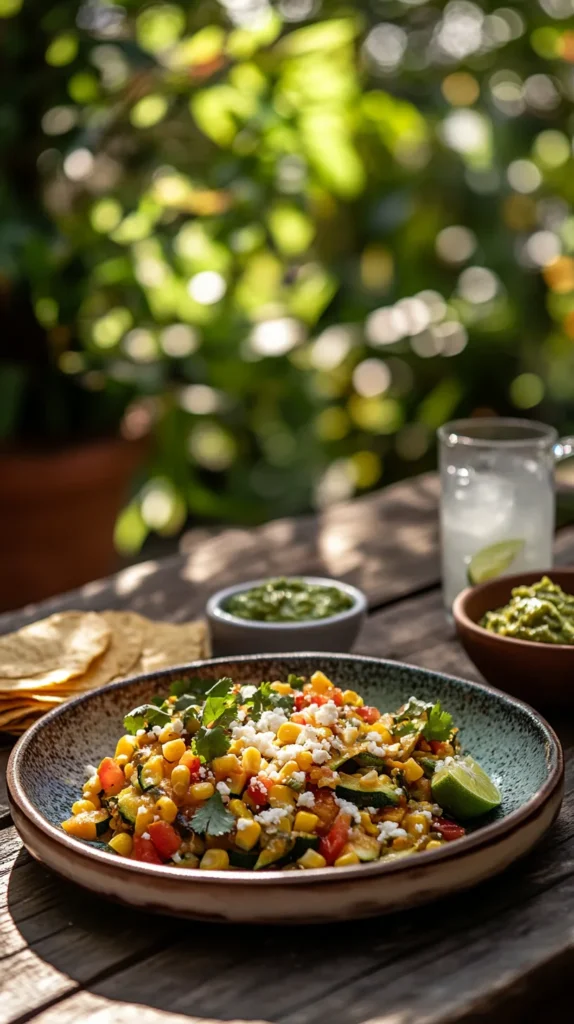
Common Mistakes to Avoid
Even though this calabacitas recipe is simple and forgiving, there are a few common pitfalls that can affect the final result. Here’s what to watch out for so your calabacitas turns out perfectly every time:
1. Overcrowding the Pan
It might be tempting to toss all your vegetables in at once, especially if you’re making a big batch, but overcrowding can lead to steaming instead of sautéeing. This can make your squash soggy and your flavors a bit flat. For the best texture, give your veggies space to breathe. If needed, cook in batches.
2. Overcooking the Zucchini
Zucchini (or Mexican squash) cooks quickly, and the difference between tender and mushy can be just a few extra minutes. You want your squash to be soft but still hold its shape and have a slight bite. Keep a close eye on it toward the end of cooking—calabacitas is best with a bit of texture.
3. Using Watery Tomatoes
While fresh tomatoes are wonderful in this calabacitas recipe, using overripe or overly juicy tomatoes can water down the dish. Roma tomatoes are a great choice because they’re meaty and not too watery. If your tomatoes release a lot of liquid, just simmer a bit longer to reduce it down.
4. Forgetting to Season Layer by Layer
A big key to building flavor in a vegetable-based dish is seasoning as you go. Add a pinch of salt when you sauté the onions, another when the zucchini goes in, and adjust again at the end. Layered seasoning helps every ingredient shine in the final dish.
5. Not Roasting or Draining the Green Chiles
Green chiles bring that signature warmth to calabacitas, but if they’re canned and not drained properly, they can add too much liquid. If you’re using fresh chiles, roasting them beforehand adds a delicious smoky depth. Either way, prep them right to avoid diluting the flavor.
6. Skipping the Finishing Touches
This one’s easy to overlook, but a little fresh lime juice, a sprinkle of cheese, or some chopped cilantro can really elevate the whole dish. These finishing touches brighten up the flavors and make the calabacitas feel complete.
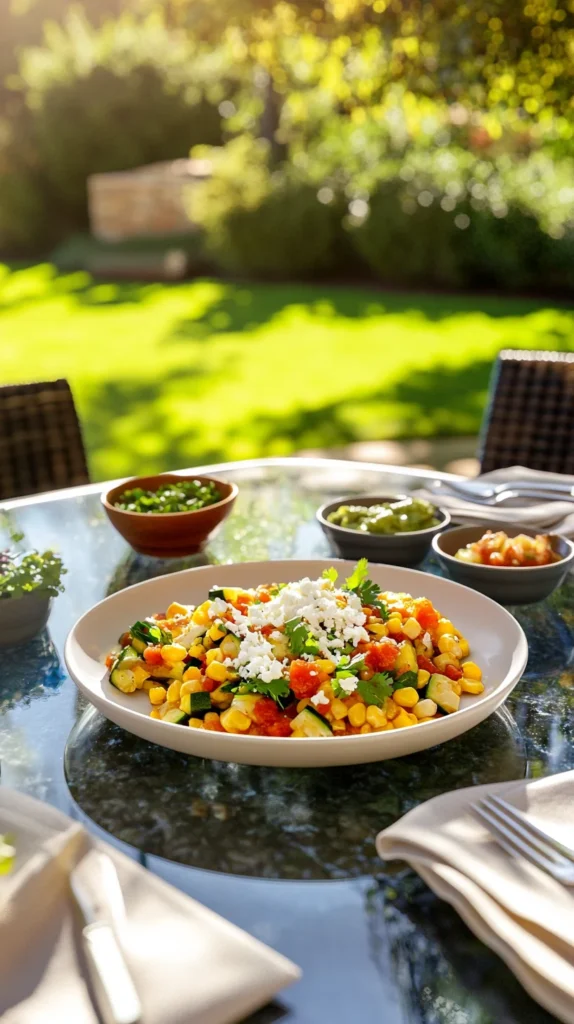
Frequently Asked Questions
1. Can I freeze calabacitas?
Absolutely. This calabacitas recipe is freezer-friendly, which makes it perfect for meal prep or saving leftovers. Let the dish cool completely, then transfer it to an airtight container. It’ll keep well in the freezer for up to 2 months. When you’re ready to enjoy it again, thaw it overnight in the fridge and reheat gently on the stovetop to preserve the texture.
2. What’s the best squash to use in calabacitas?
Traditionally, calabacitas is made with Mexican grey squash, which has a slightly sweeter, softer profile. But if you can’t find that locally, zucchini works perfectly—it’s widely available and holds up well during cooking. You can even mix in yellow squash for added color and flavor variety.
3. Can I make calabacitas ahead of time?
Yes, and it actually tastes even better the next day! The flavors have time to meld, and the texture stays lovely. Prepare the dish, let it cool, and store it in the fridge for up to 3 days. Reheat it in a skillet over medium-low heat or in the microwave for a quick and satisfying meal.
4. Is calabacitas spicy?
The basic calabacitas recipe isn’t spicy, it has a gentle warmth from the green chiles, but it’s generally mild and family-friendly. If you enjoy more heat, feel free to add diced jalapeño, a pinch of chili flakes, or a splash of your favorite hot sauce. You can easily control the spice level to suit your taste.
5. How should I serve calabacitas?
That’s the beauty of calabacitas, it’s incredibly versatile. Serve it as a hearty vegetarian main with warm tortillas, or pair it with grilled meats or fish for a more substantial meal. It also makes a delicious taco or burrito filling, and you can spoon it over rice, quinoa, or even nachos. There’s no wrong way to enjoy this delicious dish.
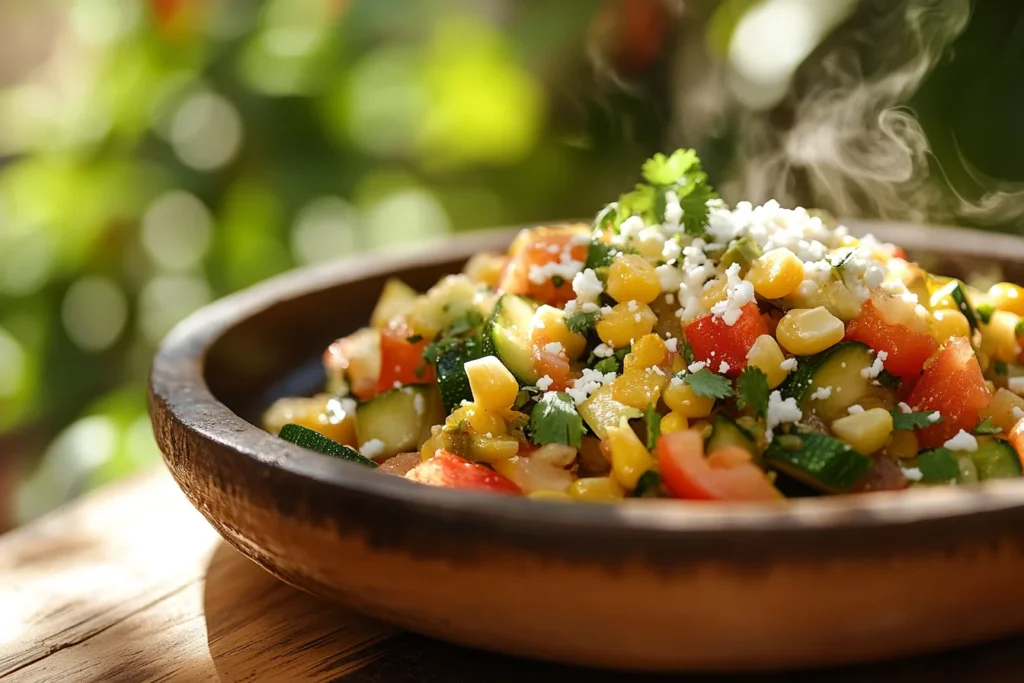
Final Thoughts on the Perfect Calabacitas Recipe
There’s something incredibly comforting about a dish that doesn’t try too hard—and that’s exactly what makes this calabacitas recipe so special. It’s unpretentious, full of flavor, and built around fresh, everyday ingredients that come together beautifully in one humble pan.
Whether you’re enjoying it as a light vegetarian main, serving it as a colorful side at your next gathering, or simply looking for a cozy, plant-based dish to add to your weeknight routine, calabacitas never disappoints. It’s the kind of recipe that feels both familiar and refreshing—rooted in tradition, yet endlessly customizable for modern kitchens.
This isn’t just a meal; it’s a reminder of how delicious simple cooking can be when done with intention. No need for complicated sauces or fancy techniques. Just good vegetables, bold flavor, and a little love.
So if you’ve been searching for a flavorful, easy-to-make dish that’s wholesome, hearty, and family-friendly, this calabacitas recipe might just be your new favorite. Keep it in your rotation, experiment with your own twists, and enjoy every spoonful.
If you enjoyed this calabacitas recipe and you’re in the mood to keep exploring bold, feel-good flavors, here’s what to try next:

- Irresistible Turkey Injection Recipe – A simple method that takes your turkey from basic to unforgettable. Perfect for holidays or any roast night.
- Cozy Chicken Pita Recipe – Tender chicken wrapped in warm pita with fresh flavors that feel like comfort on a plate.

